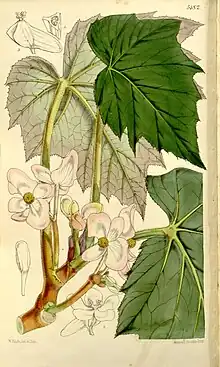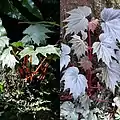| Begonia palmata | |
|---|---|
 | |
| Scientific classification | |
| Kingdom: | Plantae |
| Clade: | Tracheophytes |
| Clade: | Angiosperms |
| Clade: | Eudicots |
| Clade: | Rosids |
| Order: | Cucurbitales |
| Family: | Begoniaceae |
| Genus: | Begonia |
| Species: | B. palmata |
| Binomial name | |
| Begonia palmata | |
| Synonyms[1] | |
|
List
| |
Wikimedia Commons has media related to Begonia palmata.
Wikispecies has information related to Begonia palmata.
Begonia palmata is a species of plant in the genus Begonia of the family Begoniaceae. It is a small herb of height 20–90 cm tall. It is found in moist places, next to streams or under the shade. It is found in many parts of Asia, including eastern Himalayas.[2]
Description
Begonia palmata is an herb growing 20–90 cm tall.[2]
Distribution
Northeast India, Fujian, Guangdong etc. (check the reference for complete list) [2] up to elevation of 100–3200 meters[2][3]
Gallery
 Leaves basal and cauline
Leaves basal and cauline Flowers grow on erect stems (taken after rain). B. palmata is monoecious.
Flowers grow on erect stems (taken after rain). B. palmata is monoecious. Inflorescence dichotomous. Ovary with three wings, the dorsal wings are much longer than the flanks.
Inflorescence dichotomous. Ovary with three wings, the dorsal wings are much longer than the flanks. The male flower has 4 tepals, and the female flower has 5 tepals.
The male flower has 4 tepals, and the female flower has 5 tepals. Capsules have three wings, the dorsal wings are much longer than the flanks.
Capsules have three wings, the dorsal wings are much longer than the flanks. Young tomentose leaf
Young tomentose leaf Back of leaf in sunlight
Back of leaf in sunlight B. palmata has stout rhizomes
B. palmata has stout rhizomes
References
- ↑ "Begonia palmata D.Don". Plants of the World Online. Board of Trustees of the Royal Botanic Gardens, Kew. Retrieved 6 August 2021.
- 1 2 3 4 "Flora of China".
- ↑ "Plants for a Future".
This article is issued from Wikipedia. The text is licensed under Creative Commons - Attribution - Sharealike. Additional terms may apply for the media files.